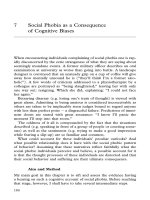- Trang chủ >>
- Khoa Học Tự Nhiên >>
- Vật lý
mind as machine a history of cognitive science two-volume set aug 2006
Bạn đang xem bản rút gọn của tài liệu. Xem và tải ngay bản đầy đủ của tài liệu tại đây (15.2 MB, 1,680 trang )
Mind as Machine:
A History of Cognitive Science,
Volume 1&2
MARGARET A. BODEN
Oxford University Press
MIND AS MACHINE
This page intentionally left blank
MIND AS
MACHINE
A History of
Cognitive Science
MARGARET A. BODEN
VOLUME 1
CLARENDON PRESS · OXFORD
2006
1
Great Clarendon Street, Oxford 26
Oxford University Press is a department of the University of Oxford.
It furthers the University’s objective of excellence in research, scholarship,
and education by publishing worldwide in
Oxford New York
Auckland Cape Town Dar es Salaam Hong Kong Karachi
Kuala Lumpur Madrid Melbourne Mexico City Nairobi
New Delhi Shanghai Taipei Toronto
With offices in
Argentina Austria Brazil Chile Czech Republic France Greece
Guatemala Hungary Italy Japan Poland Portugal Singapore
South Korea Switzerland Thailand Turkey Ukraine Vietnam
Oxford is a registered trade mark of Oxford University Press
in the UK and in certain other countries
Published in the United States
by Oxford University Press Inc., New York
Margaret A. Boden 2006
Themoralrightsoftheauthorhavebeenasserted
Database right Oxford University Press (maker)
First published 2006
All rights reserved. No part of this publication may be reproduced,
stored in a retrieval system, or transmitted, in any form or by any means,
without the prior permission in writing of Oxford University Press,
or as expressly permitted by law, or under terms agreed with the appropriate
reprographics rights organization. Enquiries concerning reproduction
outside the scope of the above should be sent to the Rights Department,
Oxford University Press, at the address above
You must not circulate this book in any other binding or cover
and you must impose this same condition on any acquirer
British Library Cataloguing in Publication Data
Data available
Library of Congress Cataloging in Publication Data
Boden, Margaret A.
Mind asmachine :a history ofcognitive science/ Margaret A.Boden.
p. cm.
Includes bibliographical references and indexes.
ISBN-13: 978–0 –19–924144–6 (alk. paper)
ISBN-10: 0–19 –924144–9 (alk. paper)
1. Cognitive science—History. I. Title.
BF311.B576 2006
153.09—dc22
2006011795
Typeset by Laserwords Private Limited, Chennai, India
Printed in Great Britain
on acid-free paper by
Biddles Ltd., King’s Lynn, Norfolk
ISBN 0–19–929237–X 978–0–19–929237–0 (Volume 1)
ISBN 0–19–924144–9 978–0–19–924144–6 (Set)
10987654321
For Ruskin and Claire,
Jehane and Alex,
and Byron, Oscar, and Lukas
—and in memory of Drew Gartland-Jones (1964–2004)
This page intentionally left blank
Tell me where is fancy bred?
Or in the heart or in the head?
How begot, how nourished?
(William Shakespeare,
The Merchant of Venice, . ii)
What a piece of work is a man! how noble in reason! how infinite in faculty! in form and
moving, how express and admirable! in action how like an angel! in apprehension how
like a god! the beauty of the world! the paragon of animals!
(William Shakespeare, Hamlet, . ii)
Even Clerk Maxwell, who wanted nothing more than to know the relation between
thoughts and the molecular motions of the brain, cut short his query with the memorable
phrase, ‘‘but does not the way to it lie through the very den of the metaphysician, strewn
with the bones of former explorers and abhorred by every man of science?’’ Let us
peacefully answer the first half of this question ‘‘Yes,’’ the second half ‘‘No,’’ and then
proceed serenely.
Our adventure is actually a great heresy. We are about to conceive of the knower as a
computing machine.
(Warren McCulloch 1948: 143)
This page intentionally left blank
ACKNOWLEDGEMENTS
A number of friends and colleagues have made constructive comments on various parts
of the manuscript, and I’d like to thank them here. I’m grateful to them all—none of
whom, of course, is responsible for any errors that remain.
Some have read one or more entire chapters, and I’m especially obliged to them:
Jane Addams Allen, Jack Copeland, Paul Harris, Inman Harvey, Gerry Martin, Pasha
Parpia, Geoff Sampson, Elke Schreckenberg, Aaron Sloman, and Chris Thornton.
Many others have checked individual sections or part-sections, or sent me their
published and/or unpublished papers, or provided other helpful information. The book
has been hugely improved by their input.
Accordingly, I thank Igor Alexander, John Andreae, Michael Arbib, Alan Baddeley,
Simon Baker, Paul Ballonoff, Nicole Barenbaum, Eileen Barker, Jerome Barkow, Horace
Barlow, Daniel Bobrow, Robert Boyd, Pascal Boyer, Jerome Bruner, Alan Bundy, David
Burraston, Ronald Chrisley, Patricia Churchland, Dave Cliff, Rob Clowes, Harold
Cohen, Kate Cornwall-Jones, Kerstin Dautenhahn, Paul Davies, Dan Dennett, Zoltan
Dienes, Ezequiel di Paolo, Jim Doran, Stuart Dreyfus, Shimon Edelman, Ernest
Edmonds, Roy Ellen, Jeffrey Elman, Edward Feigenbaum, Uta Frith, Drew Gartland-
Jones, Gerald Gazdar, Zoubin Ghahramani, Gerd Gigerenzer, Peter Gray, Richard
Gregory, Richard Grimsdale, Stephen Grossberg, Derek Guthrie, Timothy Hall, Patrick
Hayes, Douglas Hofstadter, Owen Holland, Keith Holyoak, Eric Horvitz, Buz Hunt, Phil
Husbands, Edwin Hutchins, Steve Isard, Lewis Johnson, Phil Johnson-Laird, Bill Keller,
David Kirsh, Janet Kolodner, Bob Kowalski, David Kronenfeld, Ben Kuipers, Mike
Land, Pat Langley, Ronald Lemmen, Nigel Llewellyn, Aaron Lynch, John McCarthy,
Thorne McCarty, Drew McDermott, Alan Mackworth, Matt Mason, John Maynard
Smith, Wolfe Mays, Stephen Medcalf, Ryszard Michalski, Marvin Minsky, Steve Mithen,
Gunalan Nadarajan, Mike O’Shea, Andras Pellionisz, David Perkins, Tony Prescott,
Victor Raskin, Jasia Reichardt, Graham Richards, Peter Richerson, Edwina Rissland,
Edmund Robinson, Yvonne Rogers, Oliver Selfridge, Marek Sergot, Anil Seth, Mike
Sharples, Bradd Shore, Aaron Sloman, Karen Sparck Jones, Bob Stone, Doron Swade,
Henry Thompson, Larry Trask, Brian Vickers, Des Watson, Barbara Webb, Michael
Wheeler, Blay Whitby, Yorick Wilks, Peter Williams, Terry Winograd, David Young,
Lofti Zadeh, and John Ziman.
In addition, I have profited immeasurably from the stimulating intellectual envir-
onment of the interdisciplinary Centre for Research in Cognitive Science (formerly
the School of Cognitive and Computing Sciences) at the University of Sussex. Indeed,
many of the names just listed are/were among my colleagues there.
Celia McInnes has patiently put my bibliography items into the required format,
printed out countless draft chapters, and for the ten years that I have been working on
this project has helped to keep me as near to sanity as I ever manage. Peter Momtchiloff
and Laurien Berkeley of OUP, and Jacqueline Korn of David Higham Associates, have
been very helpful too. Peter, in particular, has offered a rare degree of intellectual
understanding, common sense, and (not least) patience.
x ACKNOWLEDGEMENTS
I’m grateful to the various publishers who’ve given permission to reproduce diagrams
originally published by them. And I’ve occasionally cannibalized some of my own
writings, paraphrasing or reusing paragraphs here and there. Most of these brief
passages are taken from my books Artificial Intelligence and Natural Man (1977/1987)
and Computer Models of Mind (1988), or from my papers ‘Horses of a Different Color?’
(1991), ‘Is Metabolism Necessary?’ (1999), and ‘Autopoiesis and Life’ (2000).
Finally, I thank my children and close friends for their love and support, and for not
being bored stiff when I talked about how the writing was going.
M.A.B.
The author and publisher have used their best endeavours to identify and contact copyright-
holders for material reproduced in the book; if in any case a copyright-holder believes that a
permission has not been sought, they are asked to contact the author or publisher.
CONTENTS
Preface xxxiii
1. SETTING THE SCENE 1
2. MAN AS MACHINE: ORIGINS OF THE IDEA 51
3. ANTICIPATORY ENGINES 131
4. MAYBE MINDS ARE MACHINES TOO 168
5. MOVEMENTS BENEATH THE MANTLE 237
6. COGNITIVE SCIENCE COMES TOGETHER 282
7. THE RISE OF COMPUTATIONAL PSYCHOLOGY 366
8. THE MYSTERY OF THE MISSING DISCIPLINE 515
9. TRANSFORMING LINGUISTICS 590
10. WHEN GOFAI WAS NEWFAI 701
11. OF BOMBS AND BOMBSHELLS 822
12. CONNECTIONISM: ITS BIRTH AND RENAISSANCE 883
13. SWIMMING ALONGSIDE THE KRAKEN 1002
14. FROM NEUROPHYSIOLOGY TO COMPUTATIONAL
NEUROSCIENCE
1110
15. A-LIFE IN EMBRYO 1247
16. PHILOSOPHIES OF MIND AS MACHINE 1334
17. WHAT NEXT? 1444
References 1453
List of Abbreviations 1587
Subject Index 1593
Name Index 1613
This page intentionally left blank
ANALYTICAL TABLE OF CONTENTS
VOLUME I
Preface xxxiii
i. The Book xxxiii
ii. The Background xxxvii
1. SETTING THE SCENE 1
1.i. Mind and its Place in Nature 1
a. Questions, questions 2
b. How to find some answers 3
c. Never mind minds? 8
1.ii. The Scope of Cognitive Science 9
a. Of labels and cans 10
b. Two footpaths, many meadows 12
c. Why computers? 14
d. What’s in, what’s out 16
1.iii. Caveat Narrator 18
a. Beware of Whig history 19
b. Losing the Legend 21
c. The counter-cultural background 26
d. The counter-cultural somersault 31
e. Hardly hero worship 37
f. Discovering discoveries 39
g. So what’s new? 42
h. Rhetoric and publication 46
i. An explanatory can of worms 49
1.iv. Envoi 50
2. MAN AS MACHINE: ORIGINS OF THE IDEA 51
2.i. Machine as Man: Early Days 52
a. Ancient automata and Dark Age decline 53
b. In fashion again 54
xiv ANALYTICAL TABLE OF CONTENTS
2.ii. Descartes’s Mechanism 58
a. From physics to physiology 59
b. Science as cooperation 61
c. Cartesian cooperation develops 64
d. Descartes on animals— 68
e. —but just what did he mean? 69
f. Vivisection revivified 71
g. Human bodies as machines 73
2.iii. Cartesian Complications 74
a. The mind is different 74
b. Birth of a bugbear 76
c. The prospects for AI 80
2.iv. Vaucanson’s Scientific Automata 81
a. Fairs and flute-players 82
b. Theories in robotic form 84
c. Robotics, not AI 86
2.v. Mechanism and Vitalism 87
a. Animal experiments: Are they needed? 87
b. Holist chemistry 89
2.vi. The Neo-Kantian Alternative 90
a. Kant on mind and world 91
b. Biology, mechanism, teleology 93
c. Philosophies of self-realization 95
d. Goethe, psychology, and neurophysiology 96
e. The birth of morphology 99
f. Goethe’s eclipse 101
2.vii. The Self-Regulation of the Body 102
a. Automatic equilibria 102
b. The embarrassing embryo 104
c. Creative evolution 105
2.viii. The Neurophysiological Machine 107
a. Getting on one’s nerves 107
b. Reflections on the reflex 108
c. From nerves to neurones 110
d. Integration in the nervous system 114
e. How do neurones work? 115
f. Brains and machines 117
ANALYTICAL TABLE OF CONTENTS xv
2.ix. Strictly Logical Automata 119
a. Early gizmos 119
b. Logic, not psychology 122
2.x. Psychology as Mechanism—But Not as Machine 123
a. Visions of a scientific psychology 123
b. Non-empiricist psychologies 128
3. ANTICIPATORY ENGINES 131
3.i. Miracles and Mechanism 132
a. Babbage in the round 132
b. Religion and science 135
3.ii. Differences that Made a Difference 138
a. Division of labour, again 138
b. Design and disappointment 140
3.iii. Analytical Engines 142
a. From arithmetic to algebra 142
b. Programs and bugs 144
3.iv. Had Wheelwork Been Taught to Think? 146
a. For Lovelace read Babbage throughout 146
b. What Lovelace said 149
c. Babbage and AI 151
3.v. Electronic Babbage 152
a. A soulmate in Berlin 152
b. Call me MADM 155
c. Intimations of AI 157
d. Turing’s invisibility 158
e. Von Neumann’s contribution 160
3.vi. In Grandfather’s Footsteps? 162
a. Conflicting evidence 163
b. So what’s the verdict? 167
4. MAYBE MINDS ARE MACHINES TOO 168
4.i. The Turing Machine 169
a. Turing the man 169
xvi ANALYTICAL TABLE OF CONTENTS
b. Playing the game 171
c. What computation is 173
d. Only programs, not computers 176
4.ii. From Maths Towards Mind 177
a. Computers and computors 177
b. Commitment to the claim 179
c. Butwhataboutthedetails? 181
4.iii. The Logical Neurone 182
a. McCulloch the Polymath 182
b. Experimental epistemology 184
c. Enthused by logic 186
d. The young collaborator 189
e. Mind as logic machine 190
f. Initial reception 193
4.iv. The Functionalist Neurone 195
a. From calculus to computer 195
b. Function, not implementation 197
4.v. Cybernetic Circularity: From Steam-Engines to Societies 198
a. Feedback, way back 198
b. Infant interdisciplinarity 200
c. Biological roots 202
d. Information theory 204
e. Bateson, Pask, and a sip of Beer 205
4.vi. Brains as Modelling Machines 210
a. A Cambridge cyclist 211
b. Similarity isn’t enough 214
c. Craik and cognitive science 215
d. Might-have-beens 217
4.vii. Feedback Machines 218
a. Purposes of war 218
b. Post-war projects 220
4.viii. Of Tortoises and Homeostats 222
a. Robots at the festival 223
b. Of wheels and whiskers 225
c. Less sexy, more surprising 228
d. How the Homeostat worked 230
ANALYTICAL TABLE OF CONTENTS xvii
4.ix. Schism 232
a. All too human 233
b. Adaptation or meaning? 235
5. MOVEMENTS BENEATH THE MANTLE 237
5.i. Newtonianism 238
a. The six assumptions 238
b. What sort of revolution was it? 240
5.ii. Psychology’s House 241
a. Sitting tenants with personality 242
b. Sitting tenants with knowledge 247
c. Sitting tenants with biology 252
5.iii. Soft Centres 257
a. Mentalism goes underground 257
b. Behaviourism softens 260
c. Behaviourist machines 262
5.iv. Neurology Creeps In 264
a. Hierarchies in the brain 265
b. Connectionism named 268
c. The cell assembly 271
d. Beyond perceptual learning 274
e. Hebb’s originality? 276
f. Loosening the mantle 278
6. COGNITIVE SCIENCE COMES TOGETHER 282
6.i. Pointers to the Promised Land 283
a. Informed by information 283
b. Miller and magic 286
c. Going with the flow 289
d. Information and computation 293
e. Chomsky comes on the scene 296
6.ii. The New Look 298
a. Coins and cards 299
b. A study of thinking 304
c. Computational couture 307
d. Costume change 311
e. Will seeing machines have illusions? 313
xviii ANALYTICAL TABLE OF CONTENTS
6.iii. From Heuristics to Computers 317
a. The economics of thought 318
b. A meeting of minds 320
c. A new dawn 323
6.iv. The Early Church 328
a. Consciousness raising 328
b. A trio of meetings 330
c. The manifesto 336
d. The first mission station 343
e. Missionary outposts 348
f. Thesinequanon 351
6.v. Spreading the Word 354
a. Training sessions 354
b. Library tickets 356
c. Journal-ism 363
7. THE RISE OF COMPUTATIONAL PSYCHOLOGY 366
7.i. The Personal Touch 368
a. The return of the repressed 369
b. Argus with 100 eyes 373
c. From scripts to scripts 376
d. Emotional intelligence 381
e. Architect-in-waiting 385
f. Of nursemaids and grief 388
g. Free to be free 394
h. Some hypnotic suggestions 397
i. An alien appendage 402
7.ii. The Spoken Word 404
a. Psychosyntax 405
b. Up the garden path 406
c. You know, uh, well 409
d. Meaning matters 412
7.iii. Explanation as the Holy Grail 416
a. Competence and performance 417
b. Three levels, two types 419
c. The sweet smell of success 421
d. Chasing a will-o’-the-wisp? 422
ANALYTICAL TABLE OF CONTENTS xix
7.iv. Reasoning and Rationality 427
a. Simon’s ant 429
b. Productions and SOAR 430
c. The ACTs of Anderson 435
d. Models in the mind 439
e. The marriage of Craik and Montague 442
f. Irrationality rules—or does it? 444
g. Evolved for success 446
h. Give thanks for boundedness 449
7.v. Visions of Vision 451
a. Icons of the eyes 451
b. Vision from the bottom up 456
c. Maths and multimodels 459
d. The fashion for Mexican hats 462
e. Direct opposition 465
f. Let battle commence! 469
7.vi. Nativism and its Vicissitudes 472
a. The words of Adam and Eve 473
b. Some surprises from ethology 475
c. From Noam to Nim 477
d. Modish modules 481
e. But how many, exactly? 484
f. Theory of Mind 486
g. The third way 492
h. What makes higher thinking possible? 496
i. The modularization of modules 499
7.vii. Satellite Images 503
a. A telescopic vision 504
b. Forking footpaths 507
c. The Newell Test 509
d. Low focus 512
e. The bustling circus 513
8. THE MYSTERY OF THE MISSING DISCIPLINE 515
8.i. Anthropology and Cognitive Science 516
a. The beginnings of cognitive anthropology 517
b. Peoples and prototypes 519
c. Hopes and a hexagon 522
d. More taxonomies (and more Darkness than light) 523
e. And modelling, too 526
xx ANALYTICAL TABLE OF CONTENTS
8.ii. Why Invisibility? 530
a. Psychology sidelined 531
b. Skirmishes in the science wars 534
c. Top dogs and underdogs 537
d. What’s in a name? 539
e. Barkow’s baby 540
8.iii. Minds and Group Minds 543
a. Models of seamanship 544
b. Networks of navigation 547
8.iv. Mechanisms of Aesthetics 549
a. From Savanna to Sotheby’s 549
b. The seductiveness of symmetry 552
c. Universality in variety 553
8.v. Cultural Evolution 556
a. Evolution in the third world 556
b. A new mantra: BVSR 558
c. The meme of memes 562
d. Cloak uncloaked 565
8.vi. The Believable and the Bizarre 568
a. An epidemiology of belief 569
b. Religion as a cultural universal 573
c. Symbolism 577
d. The extraordinary out of the ordinary 579
e. Anything goes? 583
f. The impurity of induction 587
9. TRANSFORMING LINGUISTICS 590
9.i. Chomsky as Guru 592
a. The tenfold Chomsky myth 592
b. A non-pacific ocean 593
9.ii. Predecessors and Precursors 594
a. Why Chomsky’s ‘history’ matters 594
b. The rationalist background 596
c. The puzzle of innate ideas 597
9.iii. Not-Really-Cartesian Linguists 600
a. Descartes’s disciple 600
b. Arnauld and the abbey 602
ANALYTICAL TABLE OF CONTENTS xxi
c. The Port-Royal Grammar 602
d. Deaf-mutes and Diderot 605
9.iv. Humboldt’s Humanism 606
a. Language as humanity 607
b. Languages and cultures 609
c. Humboldt lives! 610
d. A fivefold list 611
e. Origins 612
f. Creativity of language 614
g. The inner form 616
9.v. The Status Quo Ante 618
a. Two anti-rationalist ‘isms’ 618
b. The shock of structuralism 620
c. The formalist Dane 622
d. Tutor to Chomsky 624
e. Not quite there yet 626
9.vi. Major Transformations 627
a. Chomsky’s first words 627
b. The need for a generative grammar 628
c. Beyond information theory 631
d. Transformational grammars 634
e. So what? 637
9.vii. A Battle with Behaviourism 638
a. Political agenda 639
b. That review! 641
c. Nativist notions 643
d. Universal grammar? 645
9.viii. Aftermath 647
a. Polarized passions 648
b. Revisions, revisions 650
c. Semantics enters the equation 652
9.ix. Challenging the Master 654
a. Linguistic wars 655
b. Who needs transformations? 656
c. Montagovian meanings 657
d. Transformations trounced 660
e. Why GPSG matters 662
f. Computational tractability 665
g. Linguistics eclipsed 666
xxii ANALYTICAL TABLE OF CONTENTS
9.x. The Genesis of Natural Language Processing 669
a. Ploughman crooked ground plough plough 669
b. Shannon’s shadow 671
c. Love letters and haikus 674
d. Wittgenstein and CLRU 674
e. Is perfect translation possible? 677
f. Is adequate translation achievable? 678
9.xi. NLP Comes of Age 680
a. MT resurrected 681
b. Automatic parsing 683
c. ‘What I did on my holiday’ 688
d. Semantic coherence 689
e. The seductiveness of semantic networks 692
f. Whatever will they say next? 695
g. A snippet on speech 698
VOLUME II
10. WHEN GOFAI WAS NEWFAI 701
10.i. Harbingers 702
a. When is a program not a program? 702
b. The first AI program—not! 705
c. How a program became a program 708
d. First-footings 710
e. The book of Samuel 713
f. Programmatics 715
g. First ‘Steps’ 719
h. The harbinger in the Bush 725
i. Spacewar 729
j. The empty chair at the banquet 730
10.ii. Establishment 731
a. First labs 731
b. The ripples spread 736
c. New waves 739
10.iii. The Search for Generality 739
a. SIP spawns KR 741
b. A resolution to do better 749
c. Planning progresses 752
ANALYTICAL TABLE OF CONTENTS xxiii
d. Early learning 759
e. ‘Some Philosophical Problems’ 769
10.iv. The Need for Knowledge 775
a. A triumph, and a threefold challenge 776
b. Clearer vision 781
c. Expert Systems 794
10.v. Talking to the Computer 799
a. Psychology outlaws binary 799
b. Entering the lists 801
c. LISPing in ‘English’ 805
d. Virtual cascades 808
e. NewFAI in parallel 811
f. It’s only logical! 814
10.vi. Child’s Play 817
a. The power of bugs 817
b. Complication and distribution 820
c. Pointers to the future 821
11. OF BOMBS AND BOMBSHELLS 822
11.i. Military Matters 823
a. Nurtured in war 825
b. Licklider as a military man 828
c. Star Wars and AI qualms 832
d. Les mains sales? 835
11.ii. Critics and Calumnies 838
a. The outsider 838
b. Scandal 841
c. After Alchemy 846
d. Dreyfus and connectionism 848
e. The neighbour 850
f. A sign of the times 852
g. The unkindest cut of all 855
11.iii. A Plea for Intellectual Hygiene 857
a. The insider 858
b. Natural Stupidity survives 861
11.iv. Lighthill’s Report 864
a. A badly guided missile 865
b. Clearing up the rubble 869
xxiv ANALYTICAL TABLE OF CONTENTS
11.v. The Fifth Generation 873
a. A warning shot from Japan 873
b. Self-defence in the USA 875
c. Lighthill laid to rest 879
11.vi. The Kraken Wakes 881
a. Small fry and sleeping draughts 881
b. Competition 881
12. CONNECTIONISM: ITS BIRTH AND RENAISSANCE 883
12.i. Lighting the Fuse 885
a. A long gestation 885
b. Turing and connectionism 886
c. ‘How We Know Universals’ 887
d. From logic to thermodynamics 890
12.ii. Infant Implementations 892
a. B24 bricolage 893
b. Self-organizing networks 894
c. Connections with the Ratio Club 897
d. Pandemonium 898
e. The perceptron 903
f. Excitement, and overexcitement 907
g. Enter the Adaline 909
12.iii. Attack Without Apology 911
a. The devilish duo 911
b. The opening salvo 912
c. Intransigence 916
d. The hybrid society of mind 917
e. Were they to blame? 921
12.iv. Lamps Invisible 923
a. Relegation to the background 924
b. Run and twiddle 926
c. Reinforcement and purpose 926
12.v. Behind the Scenes 928
a. Left alone to get on with it 928
b. A problem shared ? 930
c. How large is your memory? 931
d. Disillusion on distribution 934
e. Linear associative memories 935









